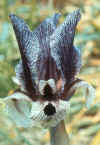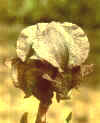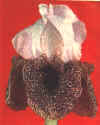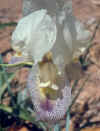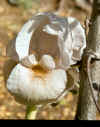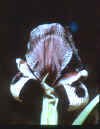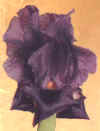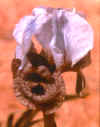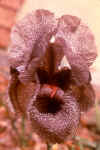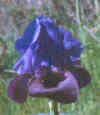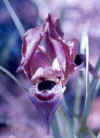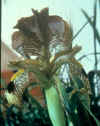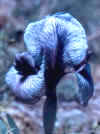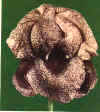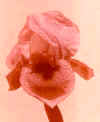The exact oncocyclus species ancestry of individual cultivars is rarely known, but we do know something of the species that were involved in the development of our foundation stock. The following is a very brief overview of the Oncocyclus Species. I am not a botanist, so this presentation does not have their level of precision. It's just a tool I've developed during some 25 years of tracing the description of species and the evolution of classification systems, contrasting and comparing the conclusions of different experts and matching subspecies, forms, variants, and synonyms used in different eras to currently accepted species. This is designed to show how the onco species fit into our modern world of arils and arilbreds - if you want the technical details, please consult the writings of Baker, Dykes, Rodienko, Mathew, etc.
I. acutiloba (Meyer, 1831) A small species whose flowers have brownish or greyish veining on light ground, a dark reddish-brown or blackish signal patch on the falls, and a sparse, dark beard. Both falls and standards are somewhat pointed. All of the following are now considered to be synonyms, subspecies, or forms of I. acutiloba: bimaculata, elizabethae, ewbankiana, helena, lineolata, schelkownikowii, and springeri. Known to have been used by C.G. White in the development of his fertile halfbreds. UNDER CONSTRUCTION
I. antilibanotica (Dinsmore & West, 1933). Large, bi-colored flowers with pale violet standards and purple-veined on purple ground falls. Small black signal and yellow beard. Considered part of the atropurpurea group in the ASI classification system. UNDER CONSTRUCTION
I. assadiana (Chaudhary, Kirkwood & Weymouth). This is a small species from the Syrian Desert, once classified as a variant of I. barnumae.
Photo not available.
I. atrofusca (Baker, 1893). A robust species from Israel. Large flowers usually have wine-colored standards and darker purplish-brown falls with a yellow beard and blackish signal patch. Known to have been used by C.G. White in the development of his fertile halfbreds.
Synonyms include Hauranensis, hauronensis, and loessicola. I. jordana, once accorded species status, is now grouped with I. atrofusca and I. atropurpurea var. gileadensis has been reassigned to I. atrofusca. UNDER CONSTRUCTION
I. atropurpurea (Baker, 1889). A very showy, "blackish" species, produced by deep violet pigments overlaying a golden ground color. The standards are often slightly lighter than the falls. The black signal patch is almost unnoticeable until the flower expands and fades with age. Bicolors, with golden standards, and golden selfs have also been observed. This species sometimes produces stolons, so has been used in hybridizing as a means of producing onco hybrids and other derivatives with more open growth habits than is typical of the type. Known to have been used by C.G. White in the development of his fertile halfbreds. Recognized variants include: eggeri and purpurea. Known to have been used by C.G. White in the development of his fertile halfbreds. UNDER CONSTRUCTION
I. auranitica (Dinsmore, 1933). Large golden yellow flowers, dotted with brown to give an overall bronze appearance. The signal patch ranges from maroon to reddish-brown. Widely used in hybridizing to introduce lighter colors in arils and arilbreds. Recognized froms include unicolor and wilkiana (which have no signals). UNDER CONSTRUCTION
I. barnumae (Baker, 1888). The flowers are a deep purplish-violet with little veining and a small black signal. Beard is usually yellow, although it may be tipped cream or purple. This proved to be one of the easier to grow oncos and has contributed significantly to our modern gene pool. Known to have been used by C.G. White in the development of his fertile halfbreds.
Synonyms include I. helenae and I. mariae, although the latter is accorded separate species status by Mathew. I. urmiensis, once accorded species status, is now considered the yellow form of I. barnumae and I. demavendica is now considered a subspecies of I. barnumae. UNDER CONSTRUCTION
I. basaltica (Dinsmore, 1933). Very large flowers have blackish purple dotting and veining on cream ground, the standards usually marked more lightly than the falls. Mathew speculated that the iris long grown in Europe as I. susiana was actually this species, in which case the name I. susiana would take precedence. UNDER CONSTRUCTION
I. bismarckiana (Damman, 1890). A strong-growing, stoloniferous plant. Flowers have cream or yellowish ground. Falls are densely covered with red-brown or purplish dots and veins, while standards are marked more lightly. Large near-black signal patch.
I. benjaminii and I. nazarena are now considered to be the same as I. bismarckiana. All have contributed to our modern aril and arilbred gene pools and I. nazarena is known to have been used by C.G. White in the development of his fertile halfbreds.
Other recognized synonyms include I. sari Nazarensis and I. sari var. lurida. UNDER CONSTRUCTION
I. bostrensis (Mouterde, 1954). Formerly known as I. atropurpurea var. purpurea, Mathew raised this to species status. Flowers are intensely dotted and veined a deep purplish brown on yellowish, greenish, or tan ground. UNDER CONSTRUCTION
I. camillae (Grossheim, 1928). An extremely variable species, with many color forms: pale blue, pale yellow, white standards with densely veined falls, bluish standards with bronze falls, blue standards with golden yellow falls. A distinguishing characteristic: the standards are larger than the falls. In the wild, it mingles with I. iberica, so some of the collected variants may be of hybrid origin. It differs from I. iberica in that its falls are narrower, less rounded, and not cupped.
Named forms include: caerulea, lutea, pallida, pseudoiberica, speciosissima, spectabilis, and sulphurea. UNDER CONSTRUCTION
Photo not available.
Photo not available.
I. gatesii (Foster, 1890). An extremely large-flowered species, native to northern Turkey and Iraq. The overall appearance is greyish or brownish, depending on the depth of the ground color and density of the dotting and veining. The sparse beard varies from yellow to dark brown.
This species is prized for its size, intricate pattern, and delicate colors, has been an important contributor to our modern aril gene pool. It has also been significant in the development of our modern arilbreds through its child, William Mohr, and its grandchild, Capitola. UNDER CONSTRUCTION
I. grossheimii (Woronow, 1928). Wine red to dark brown flowers have brownish-purple veins and a large brownish-black signal. Standards are much larger than the falls. Considered part of the acutiloba group in the ASI classification system. UNDER CONSTRUCTION
I. haynei (Baker, 1876). A large-flowered species, of overall dusky lilac appearance that is produced by intense dotting and veining on a pale ground color. Some references, including the 1939 AIS Checklist, have classified it as a form of I. atrofusca, but Mathew accords it species status. Synonym: I. biggeri Known to have been used by C.G. White in the development of his fertile halfbreds. UNDER CONSTRUCTION
I. hermona (Dinsmore, 1933). Flowers have white to creamy-yellow ground with brownish-purple veining and a rounded purplish-brown signal patch. Although the flowers resemble I. bismarckiana, the plant is non-stoloniferous. UNDER CONSTRUCTION
I. heylandiana (Boissier, 1877). A relatively small-flowered species, veined brownish on a pale ground. Quite rare in cultivation and not included in the ASI classification system. UNDER CONSTRUCTION
I. iberica (Hoffman, 1808). A dramatic, large flower with white, cream, or pale blue-violet standards that are very lightly veined and falls that are heavy stippled brown-to-purple. The color and pattern may vary, but the cupped falls and elongated style arms are distinguishing characteristics. A number of collections previously accorded species or subspecies status have since been redesignated as forms of I. iberica. These include demawendica, georgica, heterochroa, heylandica, and ibericus. Recognized variants include Pardus, Perryana, and Pantera. Ochracea and Van Houteii were selected forms introduced before the AIS registration system was instituted. Currently recognized subspecies include elegantissima and lycotis. This has been a major contributor to our modern arilbred gene pool, through its child, Ib-Mac. UNDER CONSTRUCTION
I. keredjensis (Parsa, 1941). This was collected in Iran, described as being white with a violet beard, but otherwise resembling I. barnumae. It does not appear to have been maintained in cultivation or to have contributed to our modern gene pool.
Photo not available.
I. kirkwoodii (Chaudhary, 1972). White or pale greenish ground covered with dark purple dotting and veining. Recognized subspecies: macrotepala and calcarea. Considered part of the susiana group in the ASI classification system, it has recently contributed to the arilbred gene pool.
I. lortetii (Barbey, 1881). A dramatic, large-flowered species, usually pinkish in appearance due to its fine pink or maroon dotting on a white ground. Known to have been used by C. G. White in the development of his fertile halfbreds, and used by many later hybridizers in attempts to put its delicate pattern and impressive form on an arilbred. Known to have been used by C.G. White in the development of his fertile halfbreds. I. samariae, which was once accorded separate species status, has now been reclassified as a subspecies of I. lortetii.
I. mariae (Barbey, 1891). Flowers are lilac or pinkish with deeper purple markings on the haft, a blackish-violet signal patch, and deep purple beard. The standards are much larger than the falls. Known to have been used by C.G. White in the development of his fertile halfbreds. Mathew retains its status as a separate species, but others have classified it as a subspecies of I. barnumae.
I. meda (Stapf, 1885). The white-to-cream ground color is almost obscured by golden-brown veining and infusion. The large signal patch is dark brown and the beard is yellow. UNDER CONSTRUCTION
I. nectarifera (Guner). Cream to yellow ground, veined brown or purplish brown, with yellow beard. Distinguished from I. heylandiana by narrower falls.
Photo not available.
I. nigricans (Dinsmore, 1933). Very dark, near-black self with black signal. Synonym: I. petrana. UNDER CONSTRUCTION
I. paradoxa (Steven, 1817). Standards range from white through cream and yellow to shades of violet. Falls are almost non-existent, just large enough to sport a velvety black signal. Mathew mentions the forms atrata, choschab, and mirabilis. Innes also includes paradoxa and violacea. adds Synonyms include chosab, choschob, medwedewii, and paradoxus. Click on thumbnail for more pictures and information about the influence of I. paradoxa on our modern ariil and arilbred gene pools.
Photo not available.
I. sari (Schott, 1876). Medium-sized flowers vary greatly in color, veined brown-to-purple on a cream, yellow, or greenish ground. The signal patch ranges from intense crimson to brown and the beard is yellow. Also known as I. saari, lupina, lupinda, lurida, and manissadjani. UNDER CONSTRUCTION
Photo not available.
I. sofarana (Foster, 1889). Large flowers are heavily veined brownish-violet to greyish-black on a cream to silver ground, with the standards typically marked more lightly than the falls. Known to have been used by C.G. White in the development of his fertile halfbreds.
Mathew treats it as a separate species, but others have speculated that the clone widely grown as I. susiana was actually a member of this species..
Synonyms include: kasruwana, kesruana, livida, sofanara, sofuana, and solfarana. UNDER CONSTRUCTION

I. susiana (Linneaus, 1753). The best known of the oncocyclus, because it has been in cultivation for over 400 years. Its large flower is heavily veined with deep purple on a silver-grey ground. It has a velvety black signal and a deep purple beard. It has been brought into both our aril and arilbred gene pools by hybridizers who have sought to get its fascinating flower on more gardenable plants, and is known to have been used by C.G. White in the development of his fertile halfbreds.
The I. susiana once in commerce bears a strong resemblance to both I. basaltica and I. sofarana, and some have suggested that it was a clone of one of those species. UNDER CONSTRUCTION
I. swensoniana (Chaudhary, Kirkwood & Weymouth). A dark bitone with blackish-purple falls, velvety black-maroon signal, and lighter purple standards.
Photo not available.
I. westii (Dinsmore, 1933). The standards are pale lilac with darker veins, the falls are heavily veined brown or purple on cream ground. Deep brownish-black signal patch and violet beard. This has been considered everything from a form of I. sofarana or I. susiana, to a separate species.
Photo not available.
I. yebrudii (Chaudhary, 1972). Yellowish ground. Standards have some purple veining while falls are heavily veined and dotted and veined with brownish-purple. Small, dark purple signal patch. The subspecies, Edgecombii, has somewhat larger flowers and more densely marked standards. UNDER CONSTRUCTION
Many reference books provide additional information concerning these species. See the Species List for modern equivalents of other previously-used names that are now synonyms.
A few of the more common species, like Ii. atrofusca, atropurpurea, haynei, and lortetii may still be found in catalogs but most of these species are now considered virtually unobtainable.
